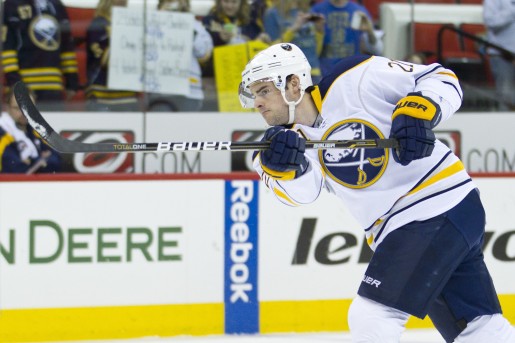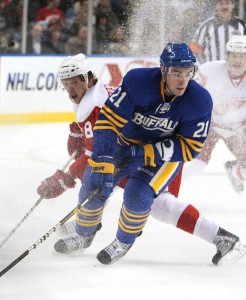A question that many Buffalo Sabres fans are asking as the April 3 trade deadline approaches is should the team trade 27-year-old, winger Drew Stafford?

Stafford’s Season So Far
Heading into the Sabres game on March 28 against the Florida Panthers, the Milwaukee native had been a healthy scratch in the previous two games. Lucky for Stafford, yet unfortunate for the Sabres, top point-getter, Thomas Vanek, who has 33 points, 16 goals, 13 assists through 29 games, suffered a muscle strain that the team was calling an upper body injury. That injury brought Stafford back into the line up.
Stafford has had a less than stellar season. He has just five goals and eight assists in 32 games for the club. In addition to his low point total the former first-rounder is a minus 12 on the season and has no points on the man advantage.
A recent survey on twiigs.com asked what should the Buffalo Sabres do with Stafford? The overwhelming response, 93 per cent of the vote to be precise, said that he had played his way off of the team and needed to be traded.
Rumors are flying that the former North Dakota University star could be heading to the Western Conference as many of their teams have sent scouts to Buffalo games, with the assumption that they are looking at Stafford.
Reasons To Trade Him
There is no doubt with the tight standings that Stafford could be a valuable asset to a team looking to make a late season run. Most teams probably have the mentality that it can’t get much worse in terms of his production this season. So with that, what is a fair return? Stafford has two years remaining on his contract that will see him earn $4-million per season, before he becomes an unrestricted free agent in the summer of 2016.
The speculation is that Stafford could fetch a top six forward and perhaps a draft pick. That is a good return for the Sabres considering they would be able to replace Stafford with a roster player and have a pick in this draft, which has been dubbed a deep one.
So the question is should the Sabres do it?
Reasons Why Not to Trade Him

Lets look at Stafford’s beginning with the Sabres. Buffalo selected Stafford in the first round, 13th overall, in the 2004 entry draft. He is a product of their system, which even included a 34-game stint with the Rochester Americans in 2006-07. So trading him, for the Sabres, is an admission that somewhere along the line something went wrong with his development. That in itself is a very tough admission for an organization to make. If you look back a few seasons ago, when division-rival Montreal, had to make a choice on which goaltender to trade, they eventually went with Jaroslav Halak, a ninth-round pick, instead of Carey Price, a first-rounder. The truth is, teams invest more in first round picks, making it harder for them to part with, even for a pick in return.
Second, let’s consider the fact that Stafford is an American-born player. This may not be a huge factor, but for a hockey-crazy market such as Buffalo having a home-grown talent, American wise at least, is a marketing feature that a foreign player simply does not provide. It is something that the team must consider, as marketing does play a role in the hockey operations of an organization.
Next, analyze Stafford’s point-production progression. Stafford showed increases in his total points in each of his first three seasons. He went from 27 in his rookie campaign, to 38 in his sophomore year, 45 in his third, before dipping to 34 points next season, he then jumped to 52 and 50 points in his fifth and sixth seasons. More impressively, up until this season, Stafford has never been a minus player. Now in 2013, Stafford is on pace to net just 17 points. One has to wonder could this just be a fluke?
The one last area to examine is Stafford’s contract. At $4-million per season, according to CapGeek, Stafford could be a bargain if he gets back to his 50+ point self as similar players who produce at that rate are paid in the $4.5-$5.5-million range. If the Sabres were to unload Stafford and he were to go back to putting up 50 points during his next two season of his current contract, it would be viewed as a huge loss for the organization.

This is the first time in his career that Stafford has struggled, now is it a sign of things to come or simply random? While fans might be fed up with Stafford this season, the truth of the matter is this has been a team effort that has the Sabres where they are. Stafford is no doubt having an off year, but doesn’t he deserve a chance to redeem himself in a Sabres uniform? It is not like the team will lose him in the offseason or even needs to make a decision on him. If he were to find his form during the summer and return to being the top-six forward that he can be next season, then all is forgotten. Right now, fans are just looking to place blame, which is entirely fair. They were sold a belief that their team would be a contender and they are not. However, the Sabres need to be very careful in fielding trade offers for a player who is in his prime and has never had similar struggles. This might very well be one of the mysteries of the lockout and if a decision is made in haste, it could affect the Sabres negatively for years to come.